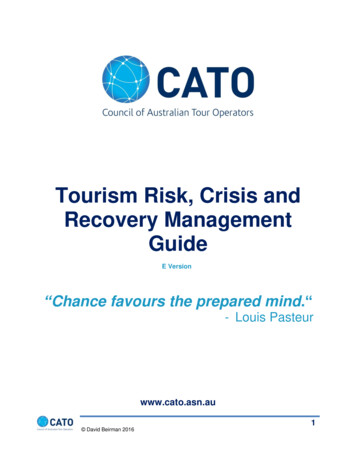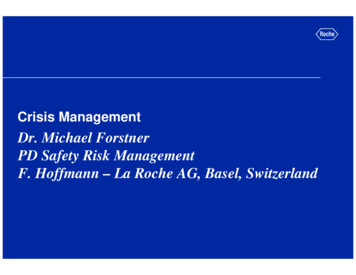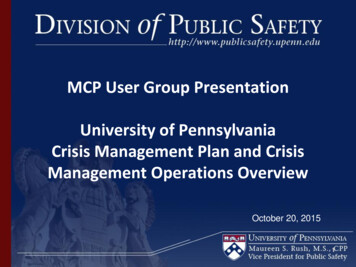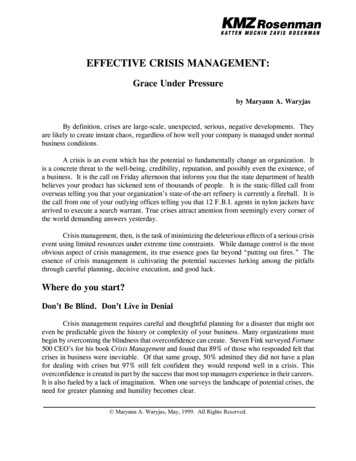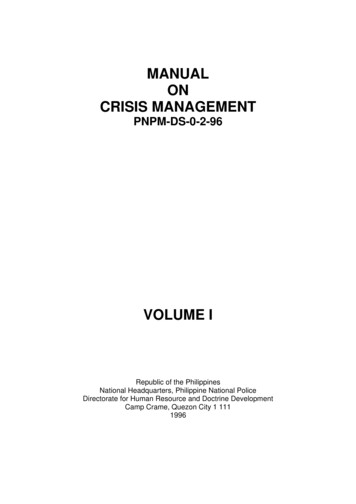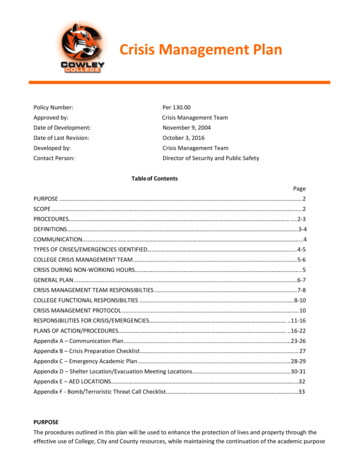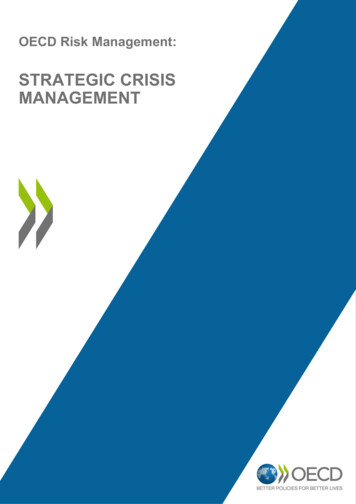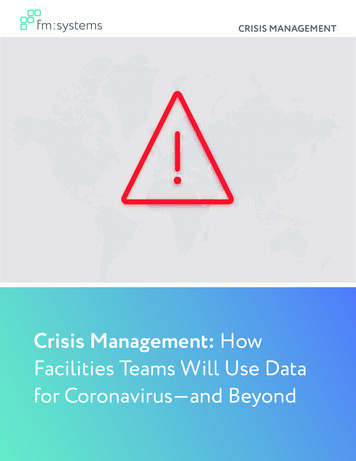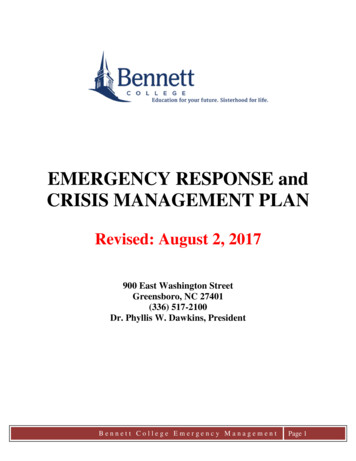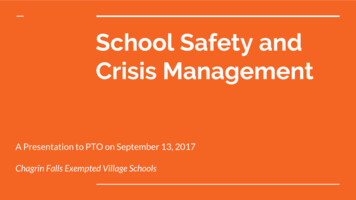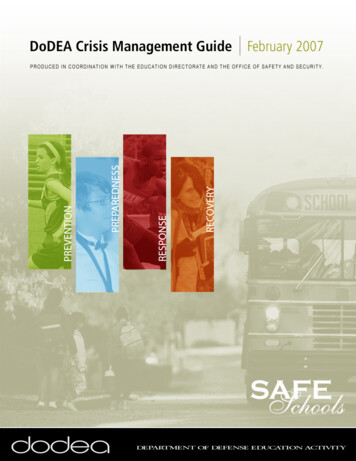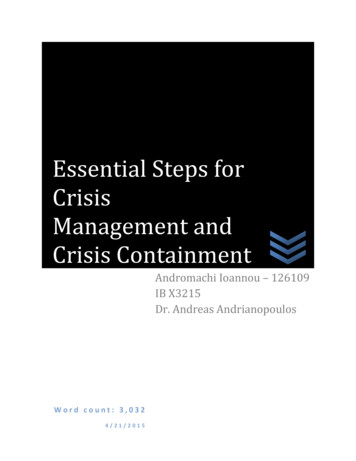
Transcription
Essential Steps forCrisisManagement andCrisis ContainmentAndromachi Ioannou – 126109IB X3215Dr. Andreas AndrianopoulosWord count: 3,0324/21/2015
2IntroductionWhile international business expansion undoubtedly presents many opportunities, thereare also a multitude of challenges that companies face when deciding to operate on a globalscale. This is because today’s international business environment is largely uncontrollable,highly uncertain and complex and constantly evolving, which exposes companies to multipleareas of risk. As a consequence, no organization, regardless of its size or strength is immunefrom a crisis that can strike unexpectedly, and that can have profound negative effects on itsoperations, can imperil future growth, profitability, and even the company’s survival. Managersmust recognize the necessity to develop the skills to handle any threat and challenge that willinevitably arise, and make it a priority to be ready to handle such a crisis, through careful andmeticulous preparation.A crisis is any situation or series of events that launch a group, team or an organizationinto a downward spiral, by threatening to harm people or property and negatively impact anddamage an organization, its stakeholders, or even an entire industry if not handled effectively andefficiently, characterized by “high consequence, low probability, ambiguity, and decisionmaking time pressure,” (J. Hale, Dulek, and D. Hale, 2005), and always creates three interrelated threats: public safety, financial loss due to disruption of operations and loss of marketshare, and inevitably reputation damage, because it reflects poorly on an organization (Coombs,2011).Taneja , et al (2014) explain that according to Mitroff, crises can be divided in sevenmajor families: economic which includes events or situations such as strikes, market crashes, andshortage of labor opportunities, informational, where there is a loss of important information ororganizational records, public or confidential, theft through phishing attacks or socialengineering or leaking of sensitive data, physical, which includes compromised majorequipment, loss of suppliers or a major disruption at a key operating plant, human resources,could be the loss of a key executive or member of the team, vandalism, or workplace violence,reputational such as rumors and gossip which can hurt the reputation of the organization. Thesixth family includes, psychopathic acts, i.e., unthinkable acts such as terrorist attacks,kidnapping or even tampering with products, and finally natural disasters, includes tornadoes,earthquakes, fire and flash floods, or outbreak of a diseaseCompanies must consider and prepare for each one, because by omitting any theypotentially make their organizations vulnerable, through effective crisis management which canbe divided into three phases: the pre-crisis phase, in which the company will aim to prevent andprepare for a crisis, the crisis response phase, when the management will actually deal with thecrisis, try to contain it and limit its damages, and the post-crisis phase, concerned with the longterm goal of recovery from damage and image restoration (Coombs, 2011).
3Pre-crisis phaseThe pre-crisis phase aims to prevent crises through risk assessment, which is “( ) theprocess of identification, analysis and response to the project risks ( )” (Petru, 2013), andconsists of scanning and analyzing the environment in order to systematically identify, assess,quantify risks by amount of importance, and prioritize the respective environmental risks to thebusiness, estimate the probability of a particular crisis occurring, its expected frequency and itspotential impact on operations. Geo-political risks that can affect companies are politicalinstability, geo-political conflict, regime changes, corruption, attitude towards foreign investorsand governance risk, which is “the ability to exercise effective control over an MNE’s operationswithin a country’s legal and political environment,” (Political Risk Assessment andManagement, 2005.), because conflicts may arise between the company’s objectives and those ofthe host governments, (such as the firm’s impact on economic development). Economic risksmay include monetary and fiscal policies, fiscal sustainability, levels of government debt anddeficit and interest rate shocks at the macro-economic level, and income distribution at themicro-economic level. Legal risks may include legislative changes and discriminatorygovernment regulations. Social factors that can cause a crisis are social unrest such as riots andstrikes and cultural differences. Environmental factors have to do with a country’s climate andgeo-political location which can cause natural disasters in extreme situations. Risks at the globallevel are associated with the country’s economic associations, intergovernmental relations,terrorism and war, anti-globalization movement, environmental concerns, poverty, orcyberattacks. (Schaechter, 2013)These risks can be assessed by using professional risk analysts who create firm-specificreports by relating risk attributes of specific countries to the particular characteristics andvulnerabilities of their client firms. Research should take into account that different companiesmay have very different degrees of vulnerability to risk and be affected differently. (PoliticalRisk Assessment and Management, 2005) Data can be collected from local media, diplomaticsources, outstanding expert consultants, or other business persons who have had recentexperience in the host country, or even on-site visits. In order to asses a country’s risk level,companies may look for evidence of present turmoil or dissatisfaction, indications of economicstability, and trends in cultural and religious activities.Stakeholders must also be involved in the management of crises, by being made aware ofidentified potential risks through “risk communication”, which includes “conveying ongoingcrisis events to stakeholders, decision making within the crisis management team, andorganizational decisions regarding whether and what amount of information to share.” (J. Hale,Dulek, and D. Hale, 2005), in order to keep their stakeholders and employees informed andprepared to act in case of a crisis. (Taneja et al. 2014). When risks include public safety, localauthorities and emergency services should also be informed, so that they can prepare anddevelop emergency plans. When operating in a multinational setting, these communicationstrategies must be account for language barriers, different communication channels, and culturalexperiences which can differ from country to country. According to Fatima Oliveira, (2013),organizations must have a polycentric approach and be proactively educational, possiblyenlisting local help of specialists who know the public relations culture of the country. She alsoexplains that perception of risk can vary from culture to culture. For example, it was not beforeMattel recalled toy cars in 2007, due to them containing amounts of led in excess of permissible
4levels, that safety issues started being taken seriously by Chinese toy producers, who hadpreviously ignored these requests to use alternative materials, believing it an exaggeration ofminimal risks. Findings of risks assessment can then be used to start elaborating an executablecrisis management plan. (Coombs, 2011).Employees too must be prepared to contribute to crisis management, by beingknowledgeable and trained to use organizational resources, possibly through training sessions tomake them “aware of protocols, procedures, and action plans to deploy when there is animpending crisis.” (Taneja et al. 2014). According to Coombs, (2011), there should be a predesignated crisis team, multidisciplinary in nature, usually consisting of experts in “publicrelations, legal, security, operations, finance, and human resources,” and should know what tasksand responsibilities they are required to perform during a crisis. Training under differenthypothetical scenarios at least annually will help team members react faster and more effectively,to make more effective decisions, take initiatives and improve their response capacities.According to Baubion (2012), two key skills which must be emphasized are the ability to thinkcreatively and to exercise leadership, because crises are unpredictable and different in nature,requiring initiatives, and often unique and new approaches. Spokespersons who will handlecommunication during the crisis must also be pre-assigned, and ideally should be trained by thepublic relations department, and preferably possess media relations skills and effectivecommunication skills. (Coombs, 2011). Multinational enterprises should be careful to selectspokespersons who wear “the same cultural eyeglasses that the community affected by a crisisevent wears” (Fatima Oliveira, 2013) meaning who speak the language, know the preferredcommunication style of the country, and are culturally attuned.The crisis management plan must be tailored to the company’s strategy and goals.Through a business impact analysis, a company must analyze which business functions arecritical to the organization’s mission, so as to prioritize them in case of a crisis, in order to ensurebusiness continuity, the capability to “continue delivery of products or services, at acceptablepredefined levels following a disruptive incident.” (Whitworth, 2006) Planning should includemanagement of facilities, supply chain, human resources and the environment, and involve allstages of the development of operations, as well as all third parties upon whom an organization iscritically dependent on, such as suppliers. (Smith, 2003.)Finally, the organization can implement notification and monitoring systems to developforesight capacities to be able to detect and better anticipate a crisis. These can consist ofmonitoring networks, early-warning systems, intelligence networks, horizon scanning or riskradars tools. They need to be designed with a wide scope to detect early and possibly weaksignals that could prove important. For example, these systems can measure geopolitical tensionsbased on market forces. (Baubion, 2012).Besides the implementation of a crisis management plan, another strategy suggested byKi and Brown (2013), is for companies to actively use media relation campaigns to promote apositive image and perception of themselves, to create a good relationship with stakeholders,based on trust and commitment, which will shape how the public perceives the organizationduring the crisis, and lead them to be more forgiving after a crisis, minimizing attributions ofcrisis responsibility and the impact of the crisis on the company’s reputation.
5Crisis Response PhaseWhen avoidance efforts fail and a crisis is triggered, the organization goes into “crisismode” and enters the response phase, characterized by short decision time, complexity, andambiguity, since risk of immediate damage is still present. Decisive action is needed, and effortsmust be shifted into containing the crisis and minimizing damage by bringing the situation undercontrol as quickly as possible. The organization traverses a path of “observation, interpretation,choice, and dissemination—repeating the process steps numerous times”, (J. Hale, Dulek, and D.Hale, 2005).The first step towards crisis containment is to assess the situation by quickly gathering asmuch accurate information as possible. Because multinationals can be faced with crises thattranscend boundaries, and which therefore require transnational cooperation, it is important todefine the scope of the crisis, meaning whether it’s local, regional or global, It also must bedetermined which organizational areas are involved, which sectors are affected, as well as whichstakeholders, because it is important to manage a crisis on all levels and to determine whatdifferent capacities have to be mobilized. (Baubion, 2012) After the assessment, the crisismanagement team will take over and perform its pre assigned tasks by mobilizing the necessaryresources. Its composition will of course be modified for every crisis according to its nature (forexample, information technology experts would be required if the crisis involved the computersystem.) The crisis management plan however, is not a precise step-by-step guide, but more of areference tool, which provides lists of key contact information, reminders of what typicallyshould be done in a crisis, and forms to be used to document the crisis response.The next step is to communicate the situation to the public and to stakeholders. This isimportant because stakeholder perception is critical to a company’s success and therefore shouldan equal, if not more urgent priority over the technical solution. (Smith, 2003). There will be anexpectation of an immediate response, and a need for reassurance in the face of ambiguity.Effective communication happens when “information is disseminated quickly, accurately,directly, and candidly to critical stakeholders, including the media”, (J. Hale, Dulek and D. Hale,2005). A quick, well structured response allows for framing of the crisis by preventing the spreadof inaccurate information, and shows that the organization is in control and safeguards thereputation and trust that organizations have been built up. A company should always takeresponsibility by indicating awareness of the situation, and assure that more details will be madepublic when they are known, explain how stakeholders might be affected by the problem,describe corrective action being taken to reassure them, and address crucial legal, financial, andbusiness implications of the crisis, (as well as humanitarian, and technical if any exist.) (strategiccrisis management for business owners). Coombs (2011) also suggests that companies shouldalso express concern and sympathy for any victims of the crisis, therefore their communicationshould include a clear rehabilitati
The crisis management plan must be tailored to the company’s strategy and goals. Through a business impact analysis, a company must analyze which business functions are critical to the organization’s mission, so as to prioritize them in case of a crisis, in order to ensure business continuity, the capability to “continue delivery of products or services, at acceptable predefined levels .
